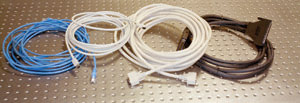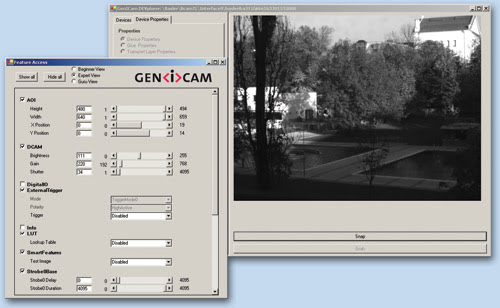The imaging community readies itself for the introduction of GigE Vision, a camera interface standard based on Gigabit Ethernet that will enable plug-and-play functionality with longer cable runs.
Hank Hogan, Contributing Editor
Robert Eastlund, vice president of sales at Graftek Imaging Inc. in Austin, Texas, naturally doesn’t like to disappoint a customer. Right now, however, his options for avoiding that are sometimes limited. Graftek, a systems integrator and component supplier, helps industrial users meet their machine vision needs, and Eastlund noted that those needs can run up against camera cabling constraints.

Camera cabling has slimmed down from RS-422 (right) to standard Gigabit Ethernet cable (left). Between them are FireWire and Camera Link cables (second to the right and to the left, respectively). The GigE Vision standard spells out how to interface cameras with Ethernet cabling, potentially allowing very long runs with inexpensive cabling. Photo by Hank Hogan.
“I’m working with a customer right at the moment that needs to run 50 feet either direction from his computer,” he explained, “and using FireWire, I’m stuck with either hubs or fiber optic links. Neither is really appealing.”
Eastlund is telling those in such straits to wait until this summer. That’s when he hopes to have better news, largely because of the GigE Vision camera interface standard being hammered out under the guidance of the Automated Imaging Association of Ann Arbor, Mich., and slated for release in May. Employing Gigabit Ethernet, a 1-Gb/s version of the Ethernet protocol used in office LANs, it will allow cable runs of 100 m or more (see “Gigabit Ethernet Finds a Foothold in High-Performance Vision,” Photonics Spectra, December 2004, page 84).

From the front, cameras that are compliant with the GigE Vision standard look no different than noncompliant devices (left). From behind, the difference is easy to spot: In addition to any other connectors, the cameras have a standard Ethernet socket (right). Courtesy of Prosilica Inc.
When combined with the already released GenICam digital camera programming interface standard developed by the European Machine Vision Association of Frankfurt, Germany, GigE Vision should provide users with a plug-and-play solution similar to but better than the FireWire (also known as IEEE-1394) interface technology used to connect cameras and PCs.
“Other than missing power on the cable, which isn’t that big of a deal in most cases, it should be just a longer cable solution exactly like IEEE-1394,” Eastlund said.
Both GigE Vision and GenICam have active support from major hardware and software vendors in the machine vision market. Manufacturers either have announced products that will support the new cabling standard or have said they plan to do so. There may be compliance issues and technical hiccups that accompany the deployment, but it is clear that camera users soon will have a choice other than FireWire and Camera Link.

GenICam is a software complement to GigE Vision, with standardized descriptions of a camera that may be stored in the device to enable plug-and-play operation. Courtesy of MVTec Software GmbH.
Of cameras and cards
Besides long cable runs, GigE Vision offers other advantages over these older standards. A Gigabit Ethernet connection is common in newer PCs, and the cards for the interface are readily available and inexpensive. Jay Kelbley, industrial camera product manager at Tucson, Ariz.-based camera maker Redlake MASD LLC, noted that Ethernet wiring is inexpensive to buy and to install.
However, GigE Vision is not the fastest possible camera interface, and it will not fit all situations. “For people who need high-bandwidth data, Camera Link will probably remain the standard,” Kelbley said.
But Camera Link’s greater speed must be considered against its 10-m limit, the high cost of its cabling and its need for a frame grabber. What’s more, a 1-Gb/s data rate is ample in many situations. Redlake, for instance, has used Gigabit Ethernet for years as a communications protocol for its high-speed and specialty cameras. GigE Vision also can leverage coming advances in Ethernet technology, such as 10 Gigabit Ethernet, which runs at 10 Gb/s, or power-over-Ethernet, which promises power and communication over a single wire.
Another advantage of using Ethernet is that it’s a packet-based transmission protocol, designed to detect errors and resend garbled data. In some industrial situations, cabling may extend for long distances through harsh environments. The ability to remove the PC from such an environment while maintaining the connection to a camera could be a substantial benefit. On the other hand, that does no good if the images and video streaming into the PC can be corrupted without being detected.
“This is why it’s important to have the ability to detect those errors and to have the mechanism to allow for retransmission if an error is detected,” said Eric Carey, manager of the smart products group at Dalsa Coreco in St. Laurent, Quebec, Canada. The company, a division of Dalsa Corp. of Waterloo, Ontario, Canada, specializes in computer vision products.
Being on Ethernet also means that the camera is on a network. Thus, it is possible to connect multiple cameras to a single PC, or a single camera to multiple PCs. The latter arrangement could be useful in situations where a camera is spitting out data too quickly for one PC to handle. The task could be farmed out to a bank of computers.
GigE Vision suffers from the difficulties that plague Ethernet, however. For cameras, one of the most vexing problems involves resolving network traffic jams. The protocol handles these by throttling down the transmission rate until the conflict disappears. So connecting a GigE Vision camera to an office network potentially makes a vision application hostage to video conference calls, e-mail, file downloads, Web surfing and anything else that consumes network bandwidth. For that reason, systems integrators recommend running separate wiring for GigE Vision.
Combining cards
Separate wiring implies a separate network interface card, unless the PC already has two. Hardware maker Matrox Electronic Systems Ltd. of Dorval, Quebec, Canada, plans to roll out cards that combine network interface cards with other functions, such as image preprocessing or digital input/output. Other vendors are likely to follow suit.
GigE Vision is largely concerned with hardware. GenICam is closer to software, noted Christoph Zierl, executive director for the development of interfaces at MVTec Software GmbH in Munich, Germany. The company, he said, is active in the GenICam arena and sees a future for it beyond the GigE Vision requirements that started GenICam’s development.
“It will also be used for other transport layers, such as Camera Link or IEEE-1394,” he predicted.
That is possible because GenICam abstracts the physical camera, turning it into a description of characteristics and properties within an xml file. This file is provided by the camera maker and, in many cases, is stored on the camera, available to be downloaded when a network connection is made.
For software makers, having GenICam enables a single driver to interface with multiple cameras. It allows camera makers to differentiate themselves by offering various capabilities instead of trying to shoehorn all devices into one-size-fits-all predefined packages. For end users, GenICam should provide plug-and-play capability. When a new camera is plugged into the network, its file can be used to automatically configure controlling software.
GenICam is integral to the GigE Vision scheme. For scheduling and flexibility reasons, those working on GigE Vision have decided to limit the mandatory camera feature set to basics, such as how to start an acquisition or how to set gain.
“The number of mandatory standard features to be defined is going to be on the order of five to 10,” said Tony Iglesias, vision hardware group manager in research and development at National Instruments Corp. of Austin, Texas. “However, GenICam is also defining a large number of standard, recommended features, such as gain and trigger mode.”
GenICam allows vendors to expand on stock features and to implement functions in different ways. The drawback of not using the recommended approach might be looser integration with third-party software.
For a standard feature such as trigger mode, third-party software could offer a user interface showing timing diagrams for each supported mode. On the other hand, if a custom trigger mode were defined, the software may be able to present only the name of the feature and the range of possible values from the xml file.
However, if one sticks to the minimal feature set required by the GigE Vision standard, that could introduce problems for end users.
“A limited mandatory feature set may have an adverse effect on camera/software out-of-the-box interoperability for typical applications,” cautioned Pierantonio Boriero, a product line manager at Matrox.
Growing pains
As is often the case with new standards, compliance is a concern. The various technical committees are actively addressing this and plan to certify both hardware and software. The goal is to ensure that everything with the GigE Vision logo seamlessly works together.
Graftek’s Eastlund had experience with FireWire when it underwent a similar process. Today, he noted, such cameras essentially are appliances: plugged in, turned on and used immediately. But the maturation of the cameras to that point took years. Eastlund is afraid that the same may happen with GigE Vision, with a lengthy process before complete compliance is achieved.
Nonetheless, he plans to add the protocol to his arsenal as soon as it becomes available.